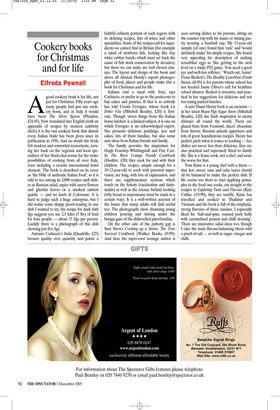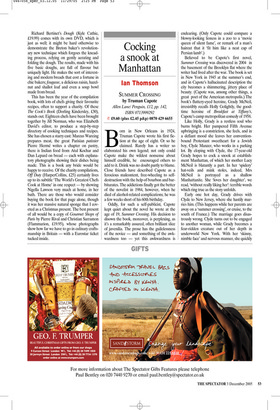Cookery books for Christmas and for life
Elfreda Pownall
Agood cookery book is for life, not just for Christmas. Fifty years ago many people had just one cookery book, and in Italy it would have been The Silver Spoon (Phaidon, £24.95). Now translated into English (with an appendix of recipes by modern celebrity chefs) it is the vast cookery book that almost every Italian bride has been given since its publication in 1950. And no doubt the bride felt modern and somewhat iconoclastic, turning her back on the regional and local specialities of her black-clad nonna for the wider possibilities of cooking from all over Italy, even including a certain international hotel element. The book is described on its cover as ‘the bible of authentic Italian food’, so it is odd to see among its 2,000 recipes such dishes as Russian salad, aspics with carrot flowers and gherkin leaves or a smoked salmon quiche — and no lardo di Colonnata. It is hard to judge such a huge enterprise, but I did notice some sloppy proof-reading in one dish I wanted to try; the recipe for duck with figs suggests you use 2.5 kilos (5 lbs) of fruit for four people — about 15 figs per person. Luckily there is a photograph of this dish showing just five figs.
Antonio Carluccio’s Italia (Quadrille, £25) favours quality over quantity and paints a faithful culinary portrait of each region, with its defining recipes, lists of wines and other specialities. Some of the recipes call for ingredients we cannot find in Britain (for example a salad of newborn fish, looking like tiny white rubber bands, which must set back the cause of fish stock conservation by decades), but those we can make are well chosen classics. The layout and design of the book and above all Alastair Hendy’s superb photography of food, places and people make this a book for Christmas and for life.
Italians end a meal with fruit, says Carluccio, or prefer to go to the pasticceria to buy cakes and pastries. If that is so nobody has told Ursula Ferrigno, whose book La Dolce Vita (Mitchell Beazley, £20) is firstrate. Though ‘sweet things from the Italian home kitchen’ is a limited subject, it is one on which Ferrigno is an acknowledged expert. She presents delicious puddings, ices and cakes, lots of them familiar, but also some new ideas from Italian friends and family.
The family provides the inspiration for Hugh Fearnley-Whittingstall and Fizz Carr. In The River Cottage Family Cookbook (Hodder, £20) they cook for and with their children. The recipes, simple enough for a 10-12-year-old to cook with parental supervision, are long, with lots of explanation, and there are supplementary sections which touch on the history (vaccination and dairymaids) as well as the science behind cooking (why bread or mayonnaise must be made in a certain way). It is a well-written account of the basics that many adults will find useful too. The photographs show charming young children pouring and stirring under the benign gaze of the dishevelled paterfamilias.
On the other side of the puberty gap is Sam Stern’s Cooking up a Storm: The Teen Survival Cookbook (Walker Books, £9.99). And here the super-cool teenage author is seen serving dishes to his parents, sitting on the counter top with his mates or mixing pastry wearing a baseball cap. My 13-year-old sample (of one) found him ‘cute’ and ‘would definitely make’ his simple recipes. She found very appealing his description of making scrambled eggs as ‘like getting to the next level on a tricky PS2 game. You need a good eye and well-fast reflexes.’ Watch out, Jamie! Fiona Beckett’s The Healthy Lunchbox (Grub Street, £8.99) is for parents whose school has not heeded Jamie Oliver’s call for healthier school dinners. Beckett is inventive and practical in her suggestions for delicious and not too taxing packed lunches.
A new Diana Henry book is an occasion in her latest Roast Figs Sugar Snow (Mitchell Beazley, £20) she finds inspiration in snowy climates all round the world. There are glazed buns from Vermont, skiers’ chocolate from Savoie, Russian zakuski appetisers and lots of great Scandinavian recipes. Henry has perfect pitch when it comes to cooking — her dishes are never less than delicious, they are also practical and supremely fitted to family life. She is a home cook, not a chef, and none the worse for that.
Tom Kime is a young chef with a thesis that hot, sweet, sour and salty tastes should all be balanced to make the perfect dish. If life seems too short to start applying principles to the food one cooks, cut straight to the recipes in Exploring Taste and Flavour (Kyle Cathie, £19.99), they are terrific. Kime has travelled and cooked in Thailand and Vietnam and the book is full of the emphatic, strong flavours of those cuisines. I especially liked his ‘Salt-and-spice roasted pork belly with caramelised peanut and chilli dressing’. There are innovative salad ideas too, though I take the main flavour-balancing thesis with a pinch of salt ... as well as sugar, vinegar and chilli. Richard Bertinet’s Dough (Kyle Cathie, £19.99) comes with its own DVD, which is just as well; it might be hard otherwise to demonstrate the Breton baker’s revolutionary new technique which forgoes the kneading process, relying on gently aerating and folding the dough. The results, made with his five basic doughs, are full of flavour but uniquely light. He makes the sort of interesting and modern breads that cost a fortune in chic bakers; fougasse, a delicious raisin, hazelnut and shallot loaf and even a soup bowl made from bread.
This has been the year of the compilation book, with lots of chefs giving their favourite recipes, often to support a charity. Of these The Cook’s Book (Dorling Kindersley, £30), stands out. Eighteen chefs have been brought together by Jill Norman, who was Elizabeth David’s editor, to produce a step-by-step directory of cooking techniques and recipes. She has chosen a starry cast: Marcus Wareing prepares meat, the great Parisian patissier Pierre Hermé writes a chapter on pastry, there is Indian food from Atul Kochar and Dan Lepard on bread — each with explanatory photographs showing their dishes being made. This is a book any bride would be happy to receive. Of the charity compilations, Off Duty (HarperCollins, £25) certainly lives up to its subtitle ‘The World’s Greatest Chefs Cook at Home’ in one respect — by showing Nigella Lawson very much at home, in her bath. There are those who would consider buying the book for that page alone, though it was her massive natural sponge that I coveted as a Christmas present. The best present of all would be a copy of Gourmet Shops of Paris by Pierre Rival and Christian Sarramon (Flammarion, £19.95), whose photographs show how far we have to go in culinary craftsmanship in Britain — with a Eurostar ticket tucked inside.




























































 Previous page
Previous page